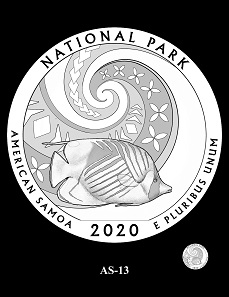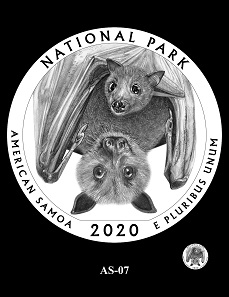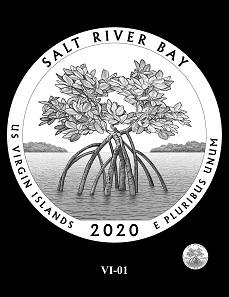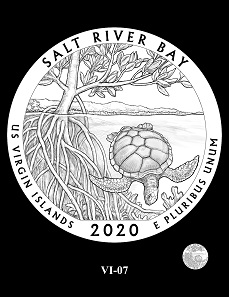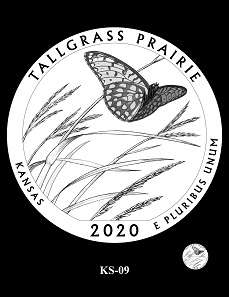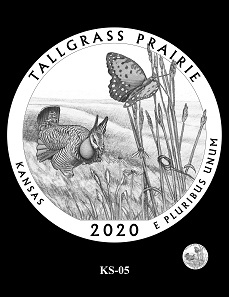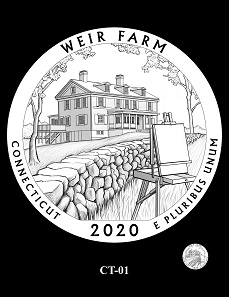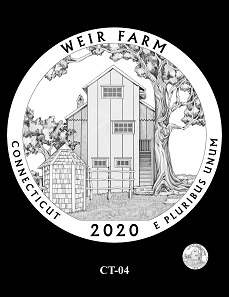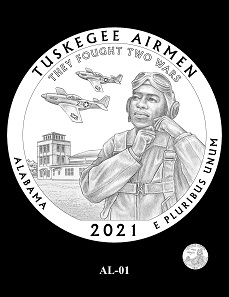November 8, 2018 – Designs depicting national parks and sites of American Samoa, Connecticut, U.S. Virgin Islands, Vermont, Kansas, and Alabama have been reviewed by the Citizens Coinage Advisory Committee (CCAC) and the Commission of Fine Arts (CFA). 63 design candidates for the 2020-2021 America the Beautiful Quarters series had previously been released by the United States Mint.
The CCAC and CFA recommendations for the design depicting the National Park of American Samoa.
American Samoa
CCAC: “There were 10 outstanding designs from which to choose, and the Committee centered on AS-13, which portrays a Threadfin Butterflyfish, a tropical fish common to American Samoa. The fish is swimming against a stylized Polynesian design of a wave, common to the Samoan tradition of tattoo. Pe’a, the Samoan word for tattoo, is also the word used for the unique Samoan Fruit Bat, thereby lending another context and deeper meaning to the design. This design received 22 of a possible 24 votes.”
CFA: “The Commission members supported the three design alternatives preferred by the site liaison. As their first choice, they recommended alternative #7 for its evocative depiction of the Samoan fruit bat. They also supported alternative #8 for its depiction of a Samoan man using a conch shell for ritual communication. Their third choice was alternative #3, with the suggestion that the composition’s dividing line be moved upward to allow more room for the depiction of the underwater scene.”
The CCAC and CFA recommendations for the design depicting the Salt River Bay National Historical Park and Ecological Preserve.
U.S. Virgin Islands
CCAC: “The Committee’s choice was quickly made among the 6 designs offered. Design VI-01, featuring a red mangrove tree in an early stage of its life cycle is a reminder of the unique and delicate natural balance of the ecosystem as this species reproduces in salt water. The design received 23 of a possible 24 votes, and the Committee commended the artistic merit of the design, with negative space allowing the mangrove to visually stand out.”
CFA: “The Commission members recommended alternative #7, which they said best combines the flora and fauna of the park; they suggested positioning the water line higher and improving the detail and visual contrast of the mangrove roots. They commented that alternative #1, the preference of the CCAC and the site liaison, has an unrealistically perfected depiction of a mangrove.”
The CCAC and CFA recommendations for the design depicting the Marsh-Billings-Rockefeller National Historical Park.
Vermont
CCAC: “Following a split decision that resulted in equal votes for two designs, but with neither design carrying the required majority, the Committee made a motion to recommend, design VT-01A. The design depicts the planting of a sugar maple sapling, representing the regeneration and conservation of the forests. Hands are gently placing the sapling in the ground, with the Green Mountains softly in the distance. The motion passed with a 6-2 vote.”
CFA: “The Commission members recommended alternative #8, the first choice of the site liaison, due to its compelling image of a child planting a tree. They suggested adding a background line in the composition to depict the silhouette of the site’s hilly topography, a feature of some of the other alternatives.
The CCAC and CFA recommendations for the design depicting the Tallgrass Prairie National Preserve.
Kansas
CCAC: “Design KS-09 shows a skyward view of a Regal Fritillary butterfly against a backdrop of Big Bluestem and Indian grasses, iconic to Tallgrass Prairie. The view of the soaring butterfly and waving grasses conveyed a sense of movement to the Committee and a breezy reminder of the endless prairies. The Committee voted this design 23 of a possible 24 points.”
CFA: “The Commission members recommended alternatives #5 and #9 as having the best potential for conveying the scale, wildlife, and grasses of the tallgrass prairie. They suggested further simplification of alternative #5 to improve the design’s clarity, perhaps omitting the prairie chicken from the composition. For alternative #9, they suggested backing out the view in order to show more of the prairie grass and to convey a sense of its dramatic height.”
The CFA provisional recommendations for the design depicting the Weir Farm National Historic Site.
Connecticut
CCAC: “On a motion during the committee meeting, the CCAC requested that the Mint provide updated designs based on committee and liaison feedback on a group of several designs out of the 15 designs presented for the reverse for the Weir Farm National Historic Site in Connecticut.”
CFA: “Acknowledging the Mint’s intention to submit revised designs for this coin, the Commission members offered several suggestions for refining the alternatives. They commented that the landscape and outdoor painting are essential themes that should be conveyed in the design. While encouraging the compositions that depict a painting on an easel in an outdoor setting, they recommended that the design convey J. Alden Weir’s Impressionist style in contrast to the landscape beyond. They commented that the low stone wall seen in alternative #1 is a distinctive feature of the Connecticut landscape that could be included in new alternatives if authentically depicted. They agreed that alternative #4 would be improved by removing the small shed at the lower left, possibly placing an easel in this part of the composition.
The CCAC and CFA recommendation for the design depicting the Tuskegee Airmen National Historic Site.
Alabama
CCAC: “The liaison’s first choice, AL-01, was also the choice of the Committee. It depicts a Tuskegee Airman pilot suiting up to join the fight during World War II with the Moton Field control tower in the background. Motion is implied as the airman adjusts the strap on his cap, looking upward as two P-51 Mustangs pass overhead. The inscription “THEY FOUGHT TWO WARS” is arced across the top as a reference to the dual battles of fascism abroad and racial discrimination at home. This design received 18 of 24 points.”
CFA: “The Commission members recommended alternative #1, consistent with the preference of the CCAC and the site liaison. They cited the text inscription as more readily understood than the cryptic double-V motif on many of the alternatives, and they supported the inclusion of the airplanes and control tower as part of the composition.”
More information on the America the Beautiful Quarters series is available on the U.S. Mint website.
The full transcript of the CCAC review and recommendation is available online.
The CFA recommendation can also be obtained from its website.
Whitman Publishing released a collectors’ handbook offering beautiful photographs and stories about each site represented in this series.
The U.S. mint also provides games parents and teachers can play with their kids to help them learn about the history of national parks and sites in the United States.





